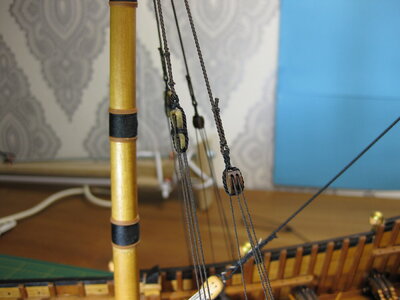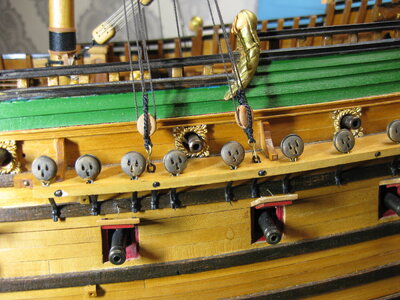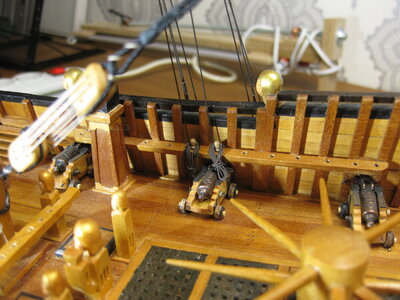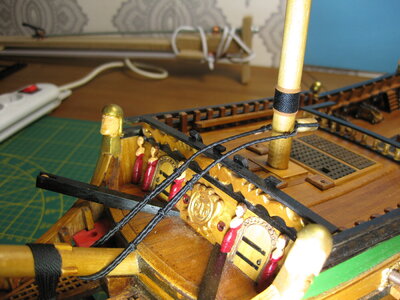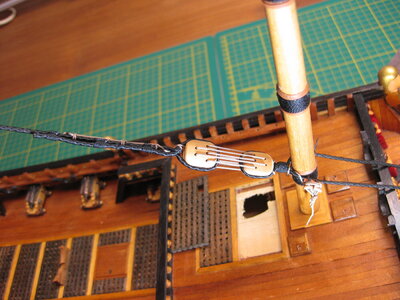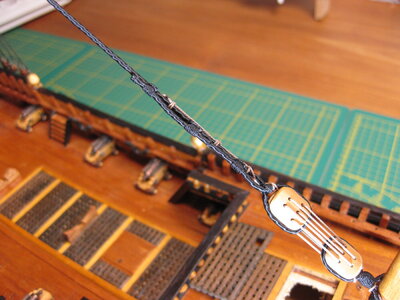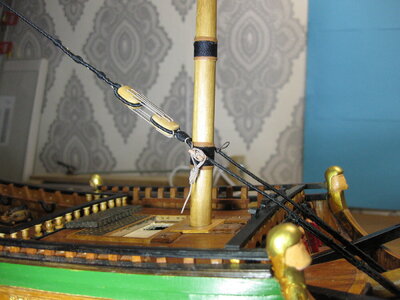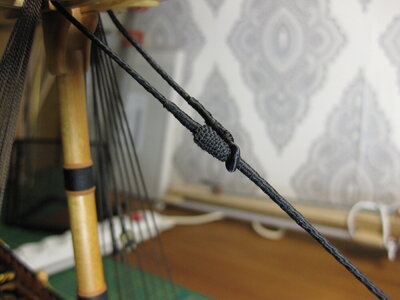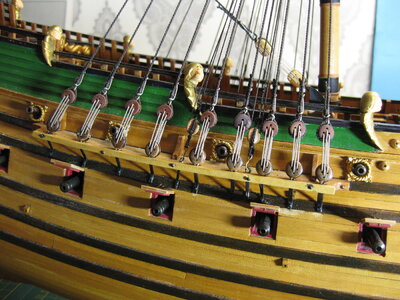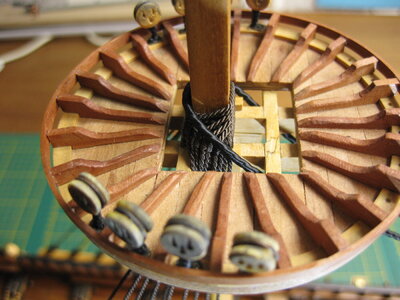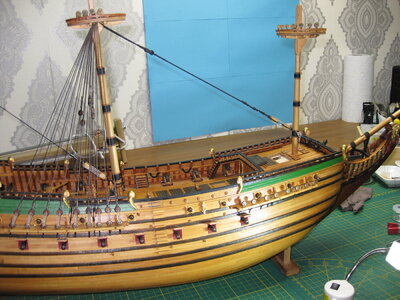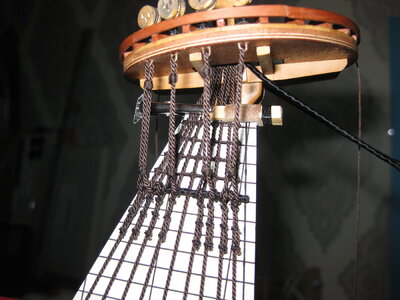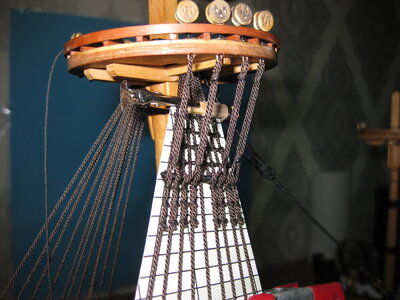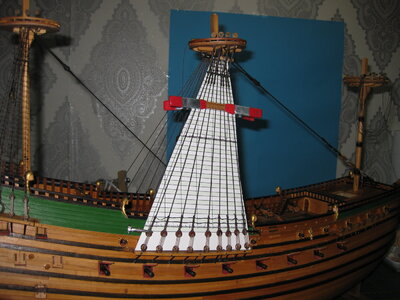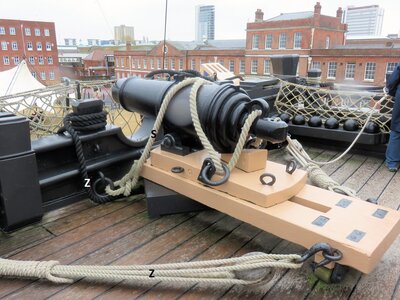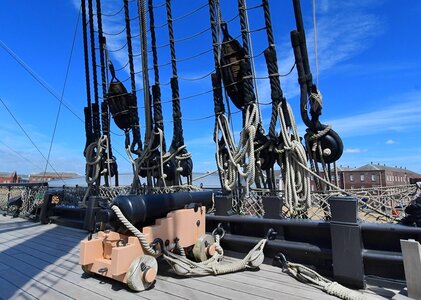-

Win a Free Custom Engraved Brass Coin!!!
As a way to introduce our brass coins to the community, we will raffle off a free coin during the month of August. Follow link ABOVE for instructions for entering.
-

PRE-ORDER SHIPS IN SCALE TODAY!
The beloved Ships in Scale Magazine is back and charting a new course for 2026!
Discover new skills, new techniques, and new inspirations in every issue.
NOTE THAT OUR FIRST ISSUE WILL BE JAN/FEB 2026
You are using an out of date browser. It may not display this or other websites correctly.
You should upgrade or use an alternative browser.
You should upgrade or use an alternative browser.
VOC ship The Prins Willem (scale 1:75) Year 1651
- Thread starter Steef66
- Start date
- Watchers 76
-
- Tags
- 1:75 prins willem
- Joined
- Aug 8, 2019
- Messages
- 5,546
- Points
- 738

Thanks @Richie I just see your build of the revenge. The colours are amazing.
About ratlines I just can tell you. Be patient, don't rush. Try to make every knot perfect. And don't do it all in one time. Do them in between other work, so it will not be boring and that will keep you accurate till the end.
About ratlines I just can tell you. Be patient, don't rush. Try to make every knot perfect. And don't do it all in one time. Do them in between other work, so it will not be boring and that will keep you accurate till the end.
- Joined
- Aug 30, 2020
- Messages
- 676
- Points
- 353

Thank you, good tips I shall keep in mind when I get to the rigging part.Thanks @Richie I just see your build of the revenge. The colours are amazing.
About ratlines I just can tell you. Be patient, don't rush. Try to make every knot perfect. And don't do it all in one time. Do them in between other work, so it will not be boring and that will keep you accurate till the end.
Stephan,
The photography and detail of the colors and sculpting has the effect of transporting the viewer along side of the ship itself. The eye is pulled from one microscopic detail to the next. For a ship and model lover it is a very heady experience. Thank you for posting!
Stan
The photography and detail of the colors and sculpting has the effect of transporting the viewer along side of the ship itself. The eye is pulled from one microscopic detail to the next. For a ship and model lover it is a very heady experience. Thank you for posting!
Stan
- Joined
- Aug 8, 2019
- Messages
- 5,546
- Points
- 738

Thanks my friend.Did you scratch-build those blocks running from the main mast?
Yes the deadeyes I make from a piece of boxwood. The tackle blocks too. Only the standaard blocks come from Kolderstok
Really good rigging works - you have a very good eye for the details of accurate rigging..... 

- Joined
- Aug 8, 2019
- Messages
- 5,546
- Points
- 738

- Joined
- Aug 8, 2019
- Messages
- 5,546
- Points
- 738

Actually I didn"t make a decision. Just not think about it .Why you decided to go this way?
I don"t even see or understand the need in using Z or S rope. Why must shrouds be Z right handed? In mine eyes they're the same, just mirrored to each other. What is the advantage? I see and read books about it. But the story's they tell, I don"t really understand them. Maybe someone can explain it in a few words that makes sense. That would be helpfull.
And don"t forget the scale is 1/75, the shrouds in the picture are 1 mm in diameter. Everything is small on this ship.
- Joined
- Feb 22, 2021
- Messages
- 130
- Points
- 253

As far I understand and how it was explained to me the difference between S or Z is about flexibility, strength and durability.
It's still for me little bit mistery why Z i stronger then S... but apparently it is. Tension of these 2 lays make big difference.
Shrouds should be always hawser Z twist rope or shroud laid (4 strand with core) unless it's made of cable then it will be left handed made of 3 hawser right handed.
As far I understood... S are more flexible... which makes them easier to handle... however this twist cause more loose twist, which is causing rope to soak the water much more easily, which leads rope to rot much faster.
So yes... there is a difference and that is why right handed ropes were use commonly for more long lasting "life" due to durability of this lay.
This is how I understand importance of different lays.
Cheers,
Matt
It's still for me little bit mistery why Z i stronger then S... but apparently it is. Tension of these 2 lays make big difference.
Shrouds should be always hawser Z twist rope or shroud laid (4 strand with core) unless it's made of cable then it will be left handed made of 3 hawser right handed.
As far I understood... S are more flexible... which makes them easier to handle... however this twist cause more loose twist, which is causing rope to soak the water much more easily, which leads rope to rot much faster.
So yes... there is a difference and that is why right handed ropes were use commonly for more long lasting "life" due to durability of this lay.
This is how I understand importance of different lays.
Cheers,
Matt
- Joined
- Aug 8, 2019
- Messages
- 5,546
- Points
- 738

Thanks Matt. Clear answer. The difference between strenght and flexibele I did read even the part of soaking water. But...

This part I fully agree. I know a lot about physics and mathematics. But I can't explain or believe why a twist of a rope make such a differce, just by twisting it the other way around. I will find out because I need to know why.... something doing with a little OCPD and hard in just believeIt's still for me little bit mistery why Z i stronger then S
- Joined
- Aug 30, 2020
- Messages
- 676
- Points
- 353

Gee, the question is difficult for me to understand and I don't think the answer helped, I am about to enter a world of uncertainty on my build.As far I understand and how it was explained to me the difference between S or Z is about flexibility, strength and durability.
It's still for me little bit mistery why Z i stronger then S... but apparently it is. Tension of these 2 lays make big difference.
Shrouds should be always hawser Z twist rope or shroud laid (4 strand with core) unless it's made of cable then it will be left handed made of 3 hawser right handed.
As far I understood... S are more flexible... which makes them easier to handle... however this twist cause more loose twist, which is causing rope to soak the water much more easily, which leads rope to rot much faster.
So yes... there is a difference and that is why right handed ropes were use commonly for more long lasting "life" due to durability of this lay.
This is how I understand importance of different lays.
Cheers,
Matt
- Joined
- Aug 8, 2019
- Messages
- 5,546
- Points
- 738

- Joined
- Aug 8, 2019
- Messages
- 5,546
- Points
- 738

I found something that makes cense to me.
on animatedknots.com I found this info about hemp, the material where ropes are made of in those early days:
History: Before the advent of synthetic fibers, industrial, marine, and climbing ropes were made of hemp that, for durability, was soaked in pine tar. Industrial hemp fiber comes from a variety of Cannabis sativa that yields only minute amounts of any psychoactive drug. Hemp fiber is one of the longest and strongest of the natural fibers. From The Classic Yacht Symposium 2006 in his “History of Rope” Bill Fronzaglia writes “…it was known that Hemp retains more strength when the yarn is twisted to the right. This resulted in a left hand strand, and a right hand rope. It wasn’t until modern times that microscopic examination of the plant illustrated that the structure of the plant has a natural twist that causes this effect.” This explains why Left Hand Strands twisted together as Right Hand lay (“Z” twist) make stronger hemp rope. Unfortunately, Fronzaglia provides us with no link to this interesting piece of research.
It means that the cellular walls of the cellulose chains have all the same angle to each other so turning into that direction the fibres keep their strength. turning against this angle gives little cracks in the cellulose chain connections. And lost of strength.
4 strands with a core in a rope give more flexibility than 3 strands
on animatedknots.com I found this info about hemp, the material where ropes are made of in those early days:
History: Before the advent of synthetic fibers, industrial, marine, and climbing ropes were made of hemp that, for durability, was soaked in pine tar. Industrial hemp fiber comes from a variety of Cannabis sativa that yields only minute amounts of any psychoactive drug. Hemp fiber is one of the longest and strongest of the natural fibers. From The Classic Yacht Symposium 2006 in his “History of Rope” Bill Fronzaglia writes “…it was known that Hemp retains more strength when the yarn is twisted to the right. This resulted in a left hand strand, and a right hand rope. It wasn’t until modern times that microscopic examination of the plant illustrated that the structure of the plant has a natural twist that causes this effect.” This explains why Left Hand Strands twisted together as Right Hand lay (“Z” twist) make stronger hemp rope. Unfortunately, Fronzaglia provides us with no link to this interesting piece of research.
It means that the cellular walls of the cellulose chains have all the same angle to each other so turning into that direction the fibres keep their strength. turning against this angle gives little cracks in the cellulose chain connections. And lost of strength.
4 strands with a core in a rope give more flexibility than 3 strands
- Joined
- Feb 22, 2021
- Messages
- 130
- Points
- 253

Stephan,
Shrouds on HMS Victory are cables, that's why is S laid. Cable is 3x hawser (right-handed) and it's the strongest option... but most expensive solution.... but this was flagship so Navy got probably some few extra pennies from Royal Vault
Lanyards are hawser so all good here and no confusions
Stays and shrouds
Again there is likely to be a discrepancy between treatises, folklore, and everyday practice. We need to build information about what practices were, at different periods, among different nationalities, on different types of vessel, and with different rigs. Archaeology is critical in verifying this information. Shroud-laid ropes, for example, were traditionally 4-strand with a central heart. Some larger vessels are supposed to have had cable shrouds. The shrouds of the Natière wrecks varied, depending on their position on the ship. Dauphine’s fore-topmast shrouds (Figs 9 and 10) were 3-strand hawsers; some of the backstays may have been the same, while some associated cables are thought to be stays or backstays. The foremast shrouds of L’Aimable Grenot were shroud-laid, while those of the mizzenmast were mostly 3-strand hawsers, with the exception of one which had a shroud knot joining it to a 4-strand shroud-laid rope, which will be discussed in a future paper. The served mizzen backstays were cablets. All of these, and the lanyards to the deadeyes, were heavily tarred. This indicates a degree of diversity far removed from neat academic classifications. The reality found aboard La Dauphine and L’Aimable Grenot is perhaps borne out by du Monceau (1769: 315 XI), who states that shroud-laid ropes are common in some ports and not others, depending on local belief. Du Monceau was trying to quantify these beliefs with scientific testing. In 1677 Dassié wrote that in France ‘the main shrouds, the fore shrouds, and the others, ought to be of three strands’
Conclusion is that shrouds should be always right handed... unless they were rigged using cables.
Depends of the vessel size shrouds could be 3 strand hawser or shroud laid, which is 4 strand right handed with core.
In term of breechings there is a lot of confusions
Have a look at the below text from Sanders publication.
Gun-carriage cordage
Again on Victory, below decks, all the gun breeching- ropes are made from either left-laid or possibly reverse-laid ropes as is the messenger for the anchor-cable. I have never personally found either rope-type on any wreck-site, and have not been able to discover when or where the decision to have these made specially for Victory originated. This goes back to at least the 1950s, when photographs of the quarterdeck show breeching-ropes which appear to be plain-laid (Z-twist hawser), but with S-twist ones on the main gundeck. In the mid 1990s all the gun-breeching ropes were switched to S-twist. More recently the anchor messenger-cable—which in the 1950s photographs was a cable—has been altered to an S twist hawser (see earlier comments about the ability to make such ropes as hawsers in the 18th century). I have been told, and Ashley (1993: 112) states, that backhanded or reverse-laid rope was used for gun-tackle ropes, and also hammocks, because it was less liable to tangle. Whether this is folklore, and, if not, when and how widely it was adopted, is something for archaeologists to help establish.
Again, the only S-twist hawser-laid rope I have encountered is a short length found in the hull of the Newport ship. Currently both gun-tackle ropes and hammock-lines on Victory are made of hawser-laid rope. Iconographic evidence is totally unreliable. Even if the original drawing was faithful, both it and a subsequent photograph can get reversed during printing and copying processes. For example, there is a drawing from the Illustrated London of 28 October 1876 showing one of Victory’s guns with S-twist breeching and gun-tackle rope. It has probably been reversed. Many of du Monceau’s images are either re-engraved copies, or were not cut as mirror images by the engraver. Once printed, this has turned many of his workers into left-handers, and turned S-cordage into Z.
of 28 October 1876 showing one of Victory’s guns with S-twist breeching and gun-tackle rope. It has probably been reversed. Many of du Monceau’s images are either re-engraved copies, or were not cut as mirror images by the engraver. Once printed, this has turned many of his workers into left-handers, and turned S-cordage into Z.
A photograph taken on HMS Superb by Nicolaas Henneman in 1845 (Science and Society Picture Library ref. 10323490), shows S-laid breeching-ropes which appear to be hawsers, not cables, around the 32-pounder guns, and Z-laid shrouds. Other Z-hawser-laid ropes in the image do indicate that in this case the print has not been reversed. An additional twist is the re-use of old rigging elements elsewhere on a vessel. John Sellar (1691: 162) states that a gunner’s stores should include old shrouds for breeching and twice-laid stuff for tackles. Add this to the probable lack of standardization of shroud cordage discussed earlier, and it suggests that a whole range of rope types might be used on guns, and that the origin of the recent Victory tradition might be as simple as someone who could not distinguish a hawser from a cable lay.
We need to find gun-tackle and breeching-ropes in situ on archaeological sites. Vasa has both, and both are regular three-stranded, Z-laid rope (pers. comm. Fred Hocker). These items have also recently been found on Stirling Castle and Northumberland, wrecked during the great storm in 1703. The Stirling Castle’s breech rope is Z-laid hawser, as are the ropes associated with the tackles (McElvogue, 2008). The matter is important, because S-twist hawser-laid breeching-ropes have appeared on HMS Warrior and in association with the Hermione replica in Rochefort. If this has no historical basis, the spread of the ‘contagion’ needs to be stopped promptly, or S-twist hawsers of varying confections will be appearing all over the place, and at considerable unnecessary expense.
You found also great explanation why right handed ropes were used.
I read some time ago that HMS Victory ropes were replaced for left handed... because that's what they've got on hand in their storage... if it's true... then somehow it's explain difference.
Running rigging should be right handed as well.
Most evidence are brought by archeological findings and ropes were right handed.
And as Sanders mentioned bringing left handed ropes to the vessels is bad practice because it's creating confusions.
Shrouds on HMS Victory are cables, that's why is S laid. Cable is 3x hawser (right-handed) and it's the strongest option... but most expensive solution.... but this was flagship so Navy got probably some few extra pennies from Royal Vault
Lanyards are hawser so all good here and no confusions
Stays and shrouds
Again there is likely to be a discrepancy between treatises, folklore, and everyday practice. We need to build information about what practices were, at different periods, among different nationalities, on different types of vessel, and with different rigs. Archaeology is critical in verifying this information. Shroud-laid ropes, for example, were traditionally 4-strand with a central heart. Some larger vessels are supposed to have had cable shrouds. The shrouds of the Natière wrecks varied, depending on their position on the ship. Dauphine’s fore-topmast shrouds (Figs 9 and 10) were 3-strand hawsers; some of the backstays may have been the same, while some associated cables are thought to be stays or backstays. The foremast shrouds of L’Aimable Grenot were shroud-laid, while those of the mizzenmast were mostly 3-strand hawsers, with the exception of one which had a shroud knot joining it to a 4-strand shroud-laid rope, which will be discussed in a future paper. The served mizzen backstays were cablets. All of these, and the lanyards to the deadeyes, were heavily tarred. This indicates a degree of diversity far removed from neat academic classifications. The reality found aboard La Dauphine and L’Aimable Grenot is perhaps borne out by du Monceau (1769: 315 XI), who states that shroud-laid ropes are common in some ports and not others, depending on local belief. Du Monceau was trying to quantify these beliefs with scientific testing. In 1677 Dassié wrote that in France ‘the main shrouds, the fore shrouds, and the others, ought to be of three strands’
Conclusion is that shrouds should be always right handed... unless they were rigged using cables.
Depends of the vessel size shrouds could be 3 strand hawser or shroud laid, which is 4 strand right handed with core.
In term of breechings there is a lot of confusions
Have a look at the below text from Sanders publication.
Gun-carriage cordage
Again on Victory, below decks, all the gun breeching- ropes are made from either left-laid or possibly reverse-laid ropes as is the messenger for the anchor-cable. I have never personally found either rope-type on any wreck-site, and have not been able to discover when or where the decision to have these made specially for Victory originated. This goes back to at least the 1950s, when photographs of the quarterdeck show breeching-ropes which appear to be plain-laid (Z-twist hawser), but with S-twist ones on the main gundeck. In the mid 1990s all the gun-breeching ropes were switched to S-twist. More recently the anchor messenger-cable—which in the 1950s photographs was a cable—has been altered to an S twist hawser (see earlier comments about the ability to make such ropes as hawsers in the 18th century). I have been told, and Ashley (1993: 112) states, that backhanded or reverse-laid rope was used for gun-tackle ropes, and also hammocks, because it was less liable to tangle. Whether this is folklore, and, if not, when and how widely it was adopted, is something for archaeologists to help establish.
Again, the only S-twist hawser-laid rope I have encountered is a short length found in the hull of the Newport ship. Currently both gun-tackle ropes and hammock-lines on Victory are made of hawser-laid rope. Iconographic evidence is totally unreliable. Even if the original drawing was faithful, both it and a subsequent photograph can get reversed during printing and copying processes. For example, there is a drawing from the Illustrated London
 of 28 October 1876 showing one of Victory’s guns with S-twist breeching and gun-tackle rope. It has probably been reversed. Many of du Monceau’s images are either re-engraved copies, or were not cut as mirror images by the engraver. Once printed, this has turned many of his workers into left-handers, and turned S-cordage into Z.
of 28 October 1876 showing one of Victory’s guns with S-twist breeching and gun-tackle rope. It has probably been reversed. Many of du Monceau’s images are either re-engraved copies, or were not cut as mirror images by the engraver. Once printed, this has turned many of his workers into left-handers, and turned S-cordage into Z.A photograph taken on HMS Superb by Nicolaas Henneman in 1845 (Science and Society Picture Library ref. 10323490), shows S-laid breeching-ropes which appear to be hawsers, not cables, around the 32-pounder guns, and Z-laid shrouds. Other Z-hawser-laid ropes in the image do indicate that in this case the print has not been reversed. An additional twist is the re-use of old rigging elements elsewhere on a vessel. John Sellar (1691: 162) states that a gunner’s stores should include old shrouds for breeching and twice-laid stuff for tackles. Add this to the probable lack of standardization of shroud cordage discussed earlier, and it suggests that a whole range of rope types might be used on guns, and that the origin of the recent Victory tradition might be as simple as someone who could not distinguish a hawser from a cable lay.
We need to find gun-tackle and breeching-ropes in situ on archaeological sites. Vasa has both, and both are regular three-stranded, Z-laid rope (pers. comm. Fred Hocker). These items have also recently been found on Stirling Castle and Northumberland, wrecked during the great storm in 1703. The Stirling Castle’s breech rope is Z-laid hawser, as are the ropes associated with the tackles (McElvogue, 2008). The matter is important, because S-twist hawser-laid breeching-ropes have appeared on HMS Warrior and in association with the Hermione replica in Rochefort. If this has no historical basis, the spread of the ‘contagion’ needs to be stopped promptly, or S-twist hawsers of varying confections will be appearing all over the place, and at considerable unnecessary expense.
You found also great explanation why right handed ropes were used.
I read some time ago that HMS Victory ropes were replaced for left handed... because that's what they've got on hand in their storage... if it's true... then somehow it's explain difference.
Running rigging should be right handed as well.
Most evidence are brought by archeological findings and ropes were right handed.
And as Sanders mentioned bringing left handed ropes to the vessels is bad practice because it's creating confusions.

